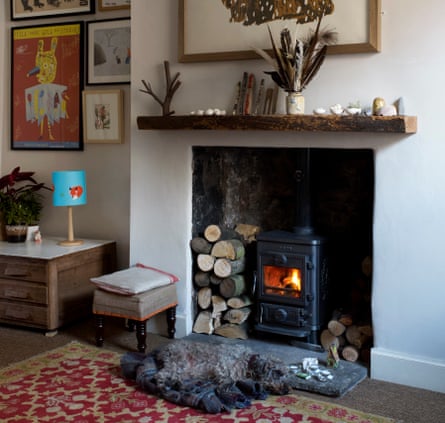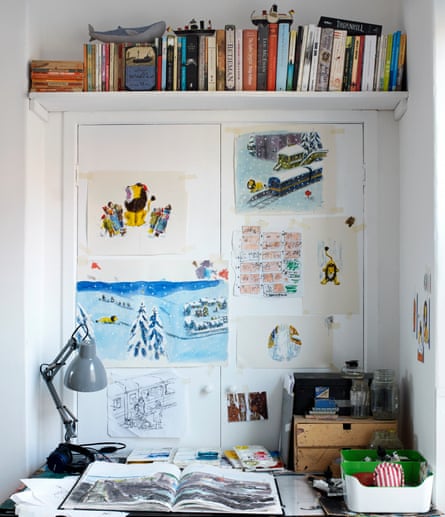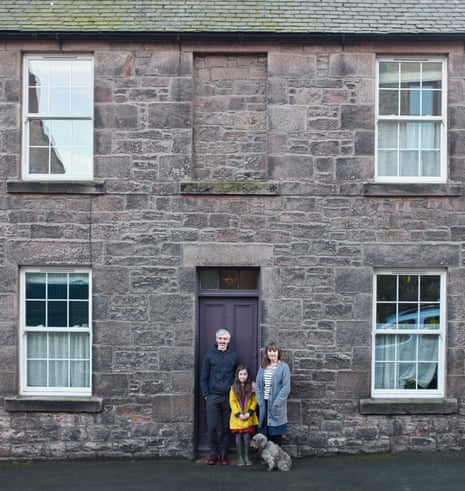Helen Stephens and her partner, Gerry Turley, may be from Darlington and Glasgow respectively, but after 17 years in London, they had forgotten how cold the north-east of England can get. It didn’t help that they arrived in Berwick-upon-Tweed in 2010, a few months before the worst winter the town had suffered in years. “The snow was so deep, it took us half an hour to walk 100 yards to the beach,” Stephens says. “When the wind whipped off the North Sea, we felt as if we were on the edge of the Earth.” Stephens joined a knitting group to get to know people; they told her to buy sturdy boots, woolly jumpers and waterproofs.
Their house was as uninsulated as they were. Turley and Stephens slept with hats on. They hung thick curtains and thermal blinds over the doors, and installed a stove in the living room. “It completely changed the atmosphere” she says. “It warms every room.” All the fireplaces had been boarded over and the couple are now gradually opening them up.

Built in the 1850s, the house was previously divided into four rooms, each inhabited by a fishing family. It was converted in the 1960s. “It’s like a child’s drawing of a house,” Stephens says. “A door in the middle and a window in each corner.” It was constructed with small rooms and windows to preserve the heat: “We have to buy small furniture – vintage pieces are usually more compact.” In the living room, the walls are filled with artwork by the couple and their friends. A fireside rug is from eBay: “We bring so much sand into the house, light-coloured carpets just wouldn’t work,” Stephens says.
She and Turley are both illustrators and share a studio downstairs. Meetings with publishers are usually conducted over Skype. But when Stephens wants to work undisturbed, away from a screen, she heads upstairs to an artfully messy desk in their bedroom. “It’s a sanctuary: emails can’t ping and I can’t hear the phone or the doorbell,” she says.

A few months after they moved in, Stephens experienced her first haar, or fog, rolling in from the sea. “They fill the town with a shimmery, silvery mist,” she says. “I got an image in my head of a bright yellow lion walking into town. It wouldn’t leave my mind, so I had to get it down on paper.” It became her picture book How To Hide A Lion, set in Berwick – the first of many.
Turley was similarly inspired: when a sperm whale was found beached locally, he drew it, and it led to a series of whales screenprinted on to found sea charts. “He likes to draw seabirds and skulls, so he collects dead ones such as gannets and puffins, and keeps them in the freezer.” The town shares this beachcomber mentality. “After a storm, everyone heads to the mouth of the river Tweed to collect driftwood,” Stephens says. “People with bags, saws, little carts and trolleys all collect kindling and logs for their fires.”

An outdoor toilet in the garden is used in summer, but in winter it’s used for storing coal. A wild cockerel roams the garden, often coming into the kitchen and leaving footprints over the chequered floor. “It’s been here for years and lives in all the gardens on our street,” Stephens says. “But it particularly likes us, as we work from home and keep it company. We daren’t give it a name or it might start to feel too at home.”
Does Berwick lack anything? “I miss the summer warmth of a big city, where you can feel the heat coming off the bricks.” At first, they also missed having a creative community, but that has since followed them. “Soon after we moved here, Alan Martin, creator of Tank Girl, moved across the road. He looked interesting, so we decided to make him our friend, whether he liked it or not. Berwick-upon-Tweed has a surprisingly large amount of writers and illustrators. It’s affordable, and I think people head up to the Edinburgh festival, see Berwick from the train and wonder what it would be like to live here. It has an attraction for creative people.”
Turley and Stephens get their “city top-ups” from visiting Edinburgh and Glasgow, but most of the time they enjoy the emptiness. “We walk on the beach with our dog every day, whatever the weather. It gets rid of the cabin fever that can set in working from home, and puts the world in perspective.”

Comments (…)
Sign in or create your Guardian account to join the discussion